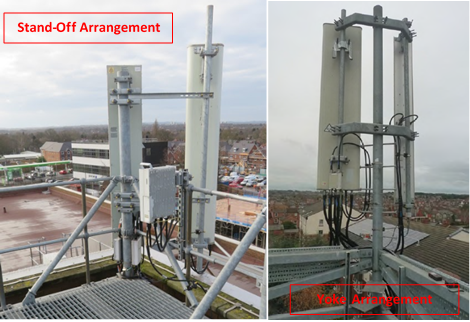
With increasing demand and fast changing technology, there is often a need to install two antennas in each sector to cover a large range of technology. Sometimes, there is enough space to install the antennas on separate primary poles, but often space is limited. For these cases, it is necessary to accommodate both antennas on a single primary pole with desired spacing to avoid clipping. There are two configurations available:
- Standoff system – One antenna on an offset pole using standoff bracket, and the other antenna on primary pole itself,
- Yoke system – Both antennae on offset poles using yoke bracket.
A standoff arrangement is often utilised when one antenna is an existing antenna and it belongs to another operator and hence it cannot be moved. However, it is an unfavourable arrangement. Due to the antenna overhang on one side, the standoff system results in eccentric loading on the primary pole which requires bigger section to support. This also transmits higher bending loads on the primary structure.
A yoke arrangement is preferable as carries two antennae on either side of the primary pole. It can provide the desired spacing between the two antennas to avoid clipping, with less overhang. It also balances the wind load and weight from either side of the bracket and results in lower bending and torsional moments on the yoke bracket and primary pole.
This ultimately results in saving material by reducing the need to have bigger and stronger steel sections.
KAEG are at the forefront of providing cost-effective design solutions to over-stressed telecommunication structures to ensure continuous safe operations. Contact our expert team at: info@ka-engroup.com to learn more and discuss how we can best serve your needs.


